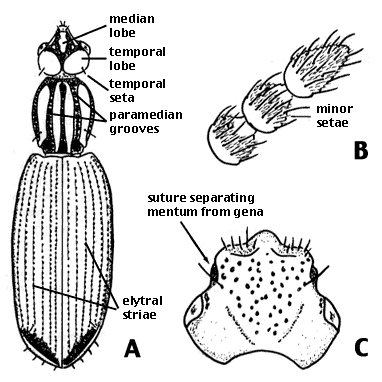Leoglymmiina
Leoglymmius lignarius
Ross T. BellIntroduction
This subtribe of Rhysodini contains one genus, Leoglymmius Bell and Bell, and a single species from Australia, L. lignarius (Ollif). This species occurs in the mountain forests of eastern Australia, from New South Wales to Tasmania. It has been found within Eucalyptus trunks in Moist Eucalyptus Forests, sometimes in the same logs as Sloanoglymmius planatus, but also in drier areas where the latter is thought to be absent.
Characteristics
With 8-10 mm in length, Leoglymmius is large for rhysodines. The antennal segments V-X have many scattered minor setae on the distal half of each segment. The eyes are large and round. The mentum is separated anteriorly from the head capsule by a narrow cleft. Dorsally the head has a shield-shaped median lobe and large convex temporal lobes which have one temporal seta. The prosternum is densely setose medially. The pronotum has complete paramedian grooves which define four broad dorsal carinae. The middle and hind tibiae each have two equal spurs. The elytron has seven punctate striae. The hind wings are present, and this species is probably capable of flight.
Relationship of Leoglymmiina to Other Rhysodines
The broad band of minor setae on each outer antennal segment is a symplesiomorphy with other tribes of Carabidae. All other Rhysodini have these setae either restricted to ventral tufts (Clinidiina) or else forming single bands on each segment (the other five tribes). The cleft between the anterior part of the mentum and the head capsule is a symplesiomorphy shared only with Sloanoglymmiina. At present no synapomorphies are known with other subtribes.
References
Bell, R. T. and J. R. Bell. 1978. Rhysodini of the World part I. A new classification of the tribe, and a synopsis of Omoglymmius subgenus Nitiglymmius, new subgenus (Coleoptera: Carabidae or Rhysodidae). Quaestiones Entomologicae 14: 43-88.
Bell, R. T. and J. R. Bell. 1991. The Rhysodini of Australia (Insecta: Coleoptera: Carabidae or Rhysodidae). Annals Of The Carnegie Museum 60(3): 179-210.
About This Page
Ross T. Bell

University of Vermont, Burlington, Vermont, USA
Page copyright © 1999 Ross T. Bell
All Rights Reserved.
- First online 14 December 1999
Citing this page:
Bell, Ross T. 1999. Leoglymmiina. Leoglymmius lignarius. Version 14 December 1999. http://tolweb.org/Leoglymmius_lignarius/1791/1999.12.14 in The Tree of Life Web Project, http://tolweb.org/









 Go to quick links
Go to quick search
Go to navigation for this section of the ToL site
Go to detailed links for the ToL site
Go to quick links
Go to quick search
Go to navigation for this section of the ToL site
Go to detailed links for the ToL site